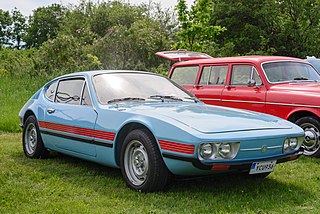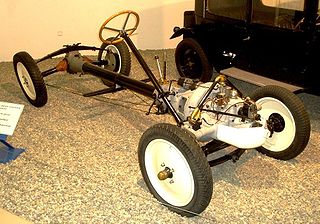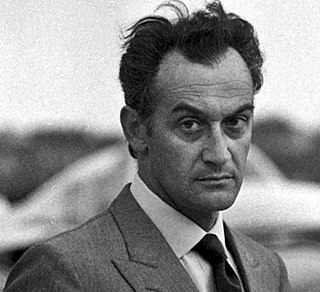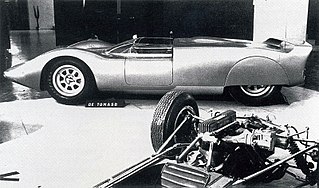
Chappe et Gessalin is the short-form of the name of French coachbuilder "Carrosserie Chappe Frères et Gessalin". The company built automobile bodies and did contract assembly for other automobile manufacturers. It was also the parent of Automobiles CG, a French automobile maker founded in 1966 which built and sold complete cars under its own name.

The AC Cobra, sold in the United States as the Shelby Cobra and AC Shelby Cobra, is a sports car manufactured by British company AC Cars, with a Ford V8 engine. It was produced intermittently in both the United Kingdom and later the United States since 1962.

Carrozzeria Ghia SpA is an Italian automobile design and coachbuilding firm, established by Giacinto Ghia and Gariglio as "Carrozzeria Ghia & Gariglio". The headquarters are located at Corso Guglielmo Marconi, 4, Turin. The company is currently owned by Ford Motor Company and focused on the European market through Ford's subsidiary in the region.

ASA was an Italian automobile manufacturer active from 1961 to 1969, who is known for manufacturing the ASA 1000 GT. This car was developed by Ferrari engineers in the late 1950s as a less expensive, compact alternative to existing Ferrari GT cars. ASA used inline-four and straight-six engines derived from the "250" 3-litre V12 designed by Gioacchino Colombo. The chassis was developed by Giotto Bizzarrini and was derived from the tubular frame chassis of the 250 GTO.

De Tomaso Automobili Ltd. is an Italian car-manufacturing company. It was founded 1959 by Alejandro de Tomaso in Modena. It originally produced various sports prototypes and auto racing vehicles, including a Formula One car for Frank Williams Racing Cars in 1970. Most of the funding for the automaker came from Amory Haskell Jr.

The De Tomaso Guarà is a sports car and the last project the founder and owner Alejandro de Tomaso put into the market. Presented at the 1993 Geneva Motor Show, the Guarà was initially available in coupé body-style. Later a roadster and an open-top barchetta bodystyle became available. The latter corresponds to the coupé but without roof and proper windscreen; a small air deflector protects the passenger and the driver from the passing wind and the car had to be driven while wearing a helmet.

The De Tomaso Pantera is a mid-engine sports car produced by Italian automobile manufacturer De Tomaso from 1971 to 1992. Italian for "Panther", the Pantera was the automaker's most popular model, with over 7,000 manufactured over its twenty-year production run. More than three quarters of the production was sold by American Lincoln-Mercury dealers from 1972 to 1975; after this agreement ended De Tomaso kept manufacturing the car in ever smaller numbers into the early 1990s.

Elva was a sports and racing car manufacturing company based in Bexhill, then Hastings and Rye, East Sussex, United Kingdom. The company was founded in 1955 by Frank G. Nichols. The name comes from the French phrase elle va.

The De Tomaso Mangusta is a sports car produced by Italian automobile manufacturer De Tomaso between 1967 and 1971. It was succeeded by the De Tomaso Pantera.

The Volkswagen SP2 is a sports car that was developed by Volkswagen do Brasil and built from July 1972 until December 1975. It is based on the chassis of the Brazilian market Volkswagen Type 3. "SP" is said to be an initialism of São Paulo, where the car was built, or of "sports prototype". In its issue of 20 June 1973, German technology magazine Hobby called the SP2 the "most beautiful Volkswagen in the world".

Backbone tube chassis is a type of automobile construction chassis that is similar to the body-on-frame design. Instead of a two-dimensional ladder-type structure, it consists of a strong tubular backbone that connects the front and rear suspension attachment areas. A body is then placed on this structure. It was first used in the English Rover 8hp of 1904 and then the French Simplicia automobile in 1909.
Tom Tjaarda was an American automobile designer noted for his work on a broad range of automobiles — estimated at over eighty — from exotic sports cars including the Ferrari 365 California and De Tomaso Pantera to high-volume popular cars including the first generation Ford Fiesta (1972) and the Fiat 124 Spider (1966).

The Djet is a French sports car designed and sold by René Bonnet (1962–1964) and then Matra (1965–1967). It was the world's first rear mid-engined production road car. Different versions were sold under a variety of names, including René Bonnet Djet, Matra-Bonnet Djet, Matra Sports Djet, and finally Matra Sports Jet.

The Corvette Stingray Racer is a sports racing car and concept car that debuted in 1959. The car was developed in the styling studios at General Motors (GM) at the behest of Bill Mitchell, GM Vice President of styling. The design was based on a sketch by designer Pete Brock, and was further developed by Larry Shinoda. The car strongly influenced the styling of the second generation (C2) Corvette Sting Ray.

The Monteverdi High Speed is a series of sports cars with different bodies produced from 1967-1976 by Swiss automaker Monteverdi. The High Speed series included several coupe models, a convertible and a sedan. In addition, the Coupé Berlinetta and the Cabriolet Palm Beach also belong to the model family.

Alejandro de Tomaso was an Argentine racing driver and businessman. His name is sometimes seen in an Italianised form as Alessandro de Tomaso. He participated in two Formula One World Championship Grands Prix, debuting on 13 January 1957. He scored no championship points. He later founded the Italian sports car company De Tomaso Automobili in 1959.

Carrozzeria Fissore was an Italian coachbuilder located in Savigliano, near Turin (Piedmont).

The De Tomaso Sport 5000 was a short-lived sports racing car built by De Tomaso in 1965. Fitted with a 289 cu in (4,736 cc) Ford V8 engine, the Sport 5000 was initially designed to be used as a Grand Tourer; however, only one car was ever built of the planned fifty, meaning that it competed solely as a sports prototype in just one race, the 1966 World Sportscar Championship Mugello 500 km.

The SSZ Stradale is an automobile developed by Tom Zatloukal, an Alfa Romeo racer and restorer, that was produced between 1984 and 1999. SSZ stands for Sprint Speciale Zatloukal. Based on the Giulietta SS, the aim was to produce a high-performance version with a lightweight and wider body than the standard production SS.
Jacques Durand was a French engineer, model builder and automobile designer. He is primarily known for designing several sports cars, which were built in small volumes in France beginning in the 1950s and continuing into the 1990s.



















